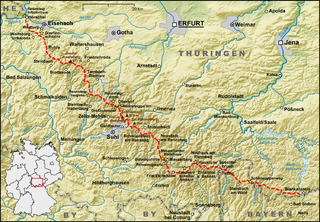Sonneberg is a Kreis (district) in the south of Thuringia, Germany. Neighboring districts are the districts Hildburghausen, Saalfeld-Rudolstadt, and the Bavarian districts Kronach and Coburg.

Gräfenthal is a town in the district of Saalfeld-Rudolstadt in Thuringia, Germany.

Lauscha is a town in the district of Sonneberg, in Thuringia, Germany. It is situated 13 km north of Sonneberg, and 24 km southwest of Saalfeld. Lauscha is known for its glassblowing, especially for Christmas tree decorations like baubles.

Neuhaus am Rennweg is a town in the district of Sonneberg, in Thuringia, Germany. It is situated in the Thuringian Forest, 17 km north of Sonneberg, and 22 km southwest of Saalfeld. The former municipalities Lichte and Piesau were merged into Neuhaus am Rennweg in January 2019.
Piesau is a village and a former municipality in the district of Sonneberg in Thuringia, Germany, close to the Thuringian Rennsteig. Formerly in the district Saalfeld-Rudolstadt, it is part of the town Neuhaus am Rennweg since January 2019.
Reichmannsdorf is a village and a former municipality in the district Saalfeld-Rudolstadt, in Thuringia, Germany. Since 1 January 2019, it is part of the town Saalfeld. Before, it belonged to the municipal association Lichtetal am Rennsteig, which consisted of the municipalities Lichte, Piesau, Reichmannsdorf, and Schmiedefeld.
Schmiedefeld is a village and a former municipality in the district Saalfeld-Rudolstadt, in Thuringia, Germany close to the Thuringian Rennsteig. Since 1 January 2019, it is part of the town Saalfeld. Before, it belonged to the municipal association Lichtetal am Rennsteig, which consisted of the municipalities Lichte, Piesau, Reichmannsdorf, and Schmiedefeld.

Lichtetal am Rennsteig is a former municipal association in the district of Saalfeld-Rudolstadt, in Thuringia, Germany. The seat of government was in Lichte. It was disbanded in January 2019.

The Thuringian Highland, Thuringian Highlands or Thuringian-Vogtlandian Slate Mountains is a low range of mountains in the German state of Thuringia.

Wallendorfer Porzellan or Wallendorf Porcelain is a porcelain manufacturing company which has been in operation since 1764 in Lichte (Wallendorf) in the Thuringian Highlands. Wallendorf is one of the oldest porcelain trademarks in Germany and the whole of Europe.

The Lichte is a right tributary of the Schwarza in Thuringia, Germany, and is 17 kilometres (11 mi) long.

The Mittelberg is an 803.6 m high mountain located in the Thuringian Highland, Thuringia (Germany).
The Hahnberg is a 685.3 m high slightly undulatory tableland located in the Thuringian Highland, Thuringia (Germany).

The Lichte porcelain (GmbH) was founded 1822 in Lichte, Thuringian Highlands.

The Lichte (Thuringia) station German: Bahnhof Lichte (Thüringen) was a Deutsche Reichsbahn station in the Thuringian municipality of Lichte in the district of Saalfeld-Rudolstadt. The station is elevated 623 m above Sea Level.

The Lichte (Thuringia) east station was a Deutsche Reichsbahn station of the Thuringian municipality of Lichte (Wallendorf) in the district of Saalfeld-Rudolstadt.
This is a list of the cultural monuments in Lichte containing all cultural monuments of the Thuringian municipality of Lichte / Lichtetal am Rennsteig, including its sections as of December 2, 2009.

The Piesau is a right tributary of the river Lichte in Thuringia, Germany. It is approximately 7 km (4.3 mi) long. The name is derived from the municipality of Piesau.

Wallendorf is an Ortsteil (subdivision) of the Lichte municipality. It is located in the district of Saalfeld-Rudolstadt in Thuringia, Germany, close to the Thuringian Rennsteig.
Saalfeld-Rudolstadt II is an electoral constituency represented in the Landtag of Thuringia. It elects one member via first-past-the-post voting. Under the current constituency numbering system, it is designated as constituency 29 and It covers the eastern part of Saalfeld-Rudolstadt.


















